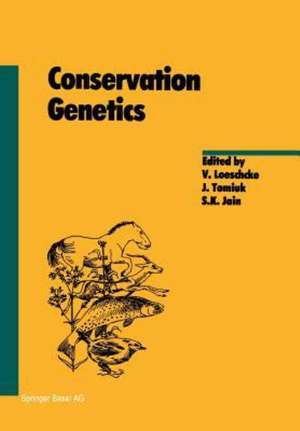Conservation Genetics: Experientia Supplementum, cartea 68
Editat de V. Loeschcke, J. Tomiuk, S. K. Jainen Limba Engleză Paperback – 30 oct 2012
| Toate formatele și edițiile | Preț | Express |
|---|---|---|
| Paperback (1) | 401.03 lei 6-8 săpt. | |
| Birkhäuser Basel – 30 oct 2012 | 401.03 lei 6-8 săpt. | |
| Hardback (1) | 596.52 lei 6-8 săpt. | |
| Birkhauser – 25 mai 1994 | 596.52 lei 6-8 săpt. |
Din seria Experientia Supplementum
- 5%
 Preț: 1343.50 lei
Preț: 1343.50 lei - 5%
 Preț: 984.91 lei
Preț: 984.91 lei -
 Preț: 330.76 lei
Preț: 330.76 lei -
 Preț: 282.83 lei
Preț: 282.83 lei -
 Preț: 302.84 lei
Preț: 302.84 lei -
 Preț: 192.21 lei
Preț: 192.21 lei - 5%
 Preț: 369.45 lei
Preț: 369.45 lei - 5%
 Preț: 382.62 lei
Preț: 382.62 lei - 15%
 Preț: 644.18 lei
Preț: 644.18 lei - 18%
 Preț: 944.51 lei
Preț: 944.51 lei - 18%
 Preț: 944.51 lei
Preț: 944.51 lei - 5%
 Preț: 715.55 lei
Preț: 715.55 lei - 15%
 Preț: 647.40 lei
Preț: 647.40 lei - 15%
 Preț: 646.94 lei
Preț: 646.94 lei - 5%
 Preț: 1430.00 lei
Preț: 1430.00 lei - 5%
 Preț: 1107.58 lei
Preț: 1107.58 lei - 5%
 Preț: 1048.73 lei
Preț: 1048.73 lei - 5%
 Preț: 902.80 lei
Preț: 902.80 lei - 5%
 Preț: 1294.47 lei
Preț: 1294.47 lei - 5%
 Preț: 1287.38 lei
Preț: 1287.38 lei - 18%
 Preț: 950.66 lei
Preț: 950.66 lei -
 Preț: 343.59 lei
Preț: 343.59 lei -
 Preț: 401.24 lei
Preț: 401.24 lei - 15%
 Preț: 666.24 lei
Preț: 666.24 lei -
 Preț: 344.36 lei
Preț: 344.36 lei -
 Preț: 383.33 lei
Preț: 383.33 lei -
 Preț: 503.74 lei
Preț: 503.74 lei -
 Preț: 388.52 lei
Preț: 388.52 lei - 15%
 Preț: 471.53 lei
Preț: 471.53 lei -
 Preț: 432.81 lei
Preț: 432.81 lei - 15%
 Preț: 480.09 lei
Preț: 480.09 lei -
 Preț: 400.47 lei
Preț: 400.47 lei -
 Preț: 377.18 lei
Preț: 377.18 lei -
 Preț: 481.58 lei
Preț: 481.58 lei - 18%
 Preț: 949.23 lei
Preț: 949.23 lei - 15%
 Preț: 505.96 lei
Preț: 505.96 lei -
 Preț: 381.43 lei
Preț: 381.43 lei -
 Preț: 390.08 lei
Preț: 390.08 lei -
 Preț: 463.41 lei
Preț: 463.41 lei -
 Preț: 424.22 lei
Preț: 424.22 lei -
 Preț: 467.43 lei
Preț: 467.43 lei -
 Preț: 381.21 lei
Preț: 381.21 lei
Preț: 401.03 lei
Nou
Puncte Express: 602
Preț estimativ în valută:
76.75€ • 83.34$ • 64.47£
76.75€ • 83.34$ • 64.47£
Carte tipărită la comandă
Livrare economică 22 aprilie-06 mai
Preluare comenzi: 021 569.72.76
Specificații
ISBN-13: 9783034896573
ISBN-10: 3034896573
Pagini: 456
Ilustrații: X, 443 p.
Greutate: 0.72 kg
Ediția:Softcover reprint of the original 1st ed. 1994
Editura: Birkhäuser Basel
Colecția Birkhäuser
Seria Experientia Supplementum
Locul publicării:Basel, Switzerland
ISBN-10: 3034896573
Pagini: 456
Ilustrații: X, 443 p.
Greutate: 0.72 kg
Ediția:Softcover reprint of the original 1st ed. 1994
Editura: Birkhäuser Basel
Colecția Birkhäuser
Seria Experientia Supplementum
Locul publicării:Basel, Switzerland
Public țintă
ResearchCuprins
I: Genetics and conservation biology.- Introductory remarks: Genetics and conservation biology.- Global issues of genetic diversity.- II: Genetic variation and fitness.- Introductory remarks.- Genetic variation and fitness: Conservation lessons from pines.- Genetic diversity and fitness in small populations.- Mutation load depending on variance in reproductive success and mating system.- Extinction risk by mutational meltdown: Synergistic effects between population regulation and genetic drift.- III: Inbreeding, population and social structure.- Introductory remarks.- Inbreeding: One word, several meanings, much confusion.- The genetic structure of metapopulations and conservation biology.- Effects of inbreeding in small plant populations: Expectations and implications for conservation.- The interaction of inbreeding depression and environmental stochasticity in the risk of extinction of small populations.- Genetic structure of a population with social structure and migration.- Guidelines in conservation genetics and the use of the population cage experiments with butterflies to investigate the effects of genetic drift and inbreeding.- IV: Molecular approaches to conservation.- Introductory remarks.- Rare alleles, MHC and captive breeding.- Andean tapaculos of the genus Scytalopus (Aves, Rhinocryptidae): A study of speciation using DNA sequence data.- Genetic distances and the setting of conservation priorities.- Multi-species risk analysis, species evaluation and biodiversity conservation.- V: Case studies.- Introductory remarks.- On genetic erosion and population extinction in plants: A case study in Scabiosa columbaria and Salvia pratensis.- Effects of releasing hatchery-reared brown trout to wild trout populations.- Genetics and demography of rare plants and patchily distributed colonizing species.- Response to environmental change: Genetic variation and fitness in Drosophila buzzatii following temperature stress.- Alternative life histories and genetic conservation.- The principles of population monitoring for conservation genetics.- VI: Genetic resource conservation.- Introductory remarks.- Optimal sampling strategies for core collections of plant genetic resources.- Conservation genetics and the role of botanical gardens.- Animal breeding and conservation genetics.- Scenarios.- Introductory remarks.- A: The genetic monitoring of primate populations for their conservation.- B: Heavy metal tolerance, plant evolution and restoration ecology.- C: Genetic conservation and plant agriculture.- D: Fragmented plant populations and their lost interactions.- E: Host-pathogen coevolution under in situ conservation.- Concluding remarks.











